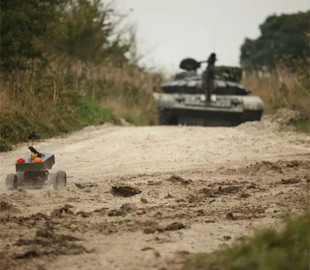To destroy main battle tanks in combat scenarios, the British Army recently tested an advanced unmanned ground vehicle (UGV) based on improvised explosive device (IED). This new mobile improvised explosive device was demonstrated in action, where it was remotely pointed at an enemy tank, underscoring the growing role of drones in modern warfare.
The test, which took place in the village of Imber at Salisbury Training Ground, was part of the British Army's Experiment and Test Group (ETG) live firing. Soldiers of the Alma Company of the 2nd Battalion of the Royal Yorkshire Regiment took part in the exercises and, judging by the photo, they destroyed the Russian T-80BVM.
This UGV (Unmanned Ground Vehicle) based Improvised Explosive Device is part of the British Army's wider Next Generation Combat Team (NGCT) concept to meet the growing demands of modern warfare, shaped by the war in Ukraine and Gaza. The NGCT initiative emphasizes the integration of unmanned aerial systems (UAS) and drones at various levels of the military organization, from the battle group to the platoon, to meet the unique challenges of the 3D battlefield. The concept aims to create a fully connected and autonomous force capable of rapid data-driven decision-making that uses both UGVs and UAS to achieve maximum operational effectiveness.
The ground-based drone tested on Salisbury Plain was designed to demonstrate the possibility of using remote-controlled explosive devices against heavily armored MBTs (main battle tanks). Traditionally, MBTs have been a formidable force on the battlefield, requiring sophisticated anti-tank weapons to counter them. This experiment with drones as carriers of improvised explosive devices is a potential solution to the problem of neutralizing MBT in difficult terrain. UGVs offer a low-cost remote solution that minimizes personnel risk while maintaining high lethality against armored targets.
200% Deposit Bonus up to €3,000 180% First Deposit Bonus up to $20,000Once at the required distance, the device can theoretically release a powerful charge capable of compromising the tank's armor. This tactic, which uses remote control and autonomous navigation, aligns with the NGCT's focus on improving Soldier engagement and autonomy through advanced technology.
The use of UGV-based mobile improvised explosive devices has significant implications for the future tactics of the British Army and the wider landscape of armored warfare. In today's multifaceted battlespace, where traditional battle lines are becoming less defined, UGV-based IEDs offer commanders a flexible and rapid tool to neutralize critical targets such as tanks without relying on manned anti-tank teams. If widely adopted, this technology could revolutionize tank engagement protocols, enabling faster, safer, and potentially more cost-effective anti-tank operations.
This test highlights the importance of networked, interoperable equipment at all levels of warfare, from the individual soldier to the platoon and company levels. Soldiers participating in the test were equipped with anti-UAV tools such as battle shotguns and DroneShields, further underscoring the Army's commitment to protecting against threats that may arise with the use of UAVs.
Group Event The Experimentation and Trials Group also provided an opportunity to explore how the British Army can better train and equip soldiers to operate on an integrated, multi-domain battlefield. Key to the NGCT approach is a significant increase in equipment and facilities at the company and platoon levels, enabling small units to be equipped with UAV and counter-UAV assets adapted to the operational challenges of modern warfare.
It is expected that the lessons learned from of these tests will form the basis for future British Army procurement strategies and training programs, emphasizing the integration of autonomous systems and unmanned systems in all echelons.

